 Guided missile Frigates 1971-2013:
Guided missile Frigates 1971-2013:FS Tourville, Duguay-Trouin, De Grasse D610-612 +2 more cancelled
Called the F67 type, also known as the Tourville class, these ships were a class of three large high-sea (blue water) Frigates specialized in anti-submarine warfare, but keeping anti-air and anti-surface capabilities (ASUW). Large enough to be cruisers, like the previous Suffren class (1967), the three Tourville class (F67 Type) were derived from the 1960s frigate Aconit. They received a destroyer pennant by NATO (D-610 to 612) given their size (6,000 tonnes), and were designed as primarily guided missile ASW escorts. Tourville, Duguay Trouin and De Grasse, built in the 1970s were active until 1999, 2011 and 2013. Between 1994 and 1996, Tourville and De Grasse wreceived a modern SLASM anti-submarine system and a new active Very Low Frequency (VLF) sonar. They took part in many missions and exercises with OTAN, and currently two are laid up and one is used as breakwater. #frenchnavy #marinenationale #tourville #degrasse #frigates #guidedmissilefrigates

Development

The previous Aconit
This program of five “corvettes” initially answered the need to adress the better performances of submarines in the 1960s. The C65 program (Aconit) was calling two innovative systems recently developed, the DUBV43 active towed sonar and Malafon torpedo-carrying missile. This was considered the ultimate evolution of the T 47 class escorts (destroyers) for anti-submarine warfare. Speed was not good enough with a propulsion development both long and laborious.
The program thus stoped after the first unit delivered, and the design of a large ocean-going anti-submarine ship under the C67 program was started in 1969 and proceeded quickly as the plan was approved in Janury 1970 and the first was laid down in April.
This F67 Tourville type was balsically an enlarged and modified Aconit. The latter was a single shaft austere ship designed for mass production in case of war, it was ultimately unsuccessful. The Tourville were a new take on the ASW frigate, with double the tonnage, two shaft steam turbines and a double hangar for two Lynx WG13 helicopters, for a more effective ASW cover. They were also the first ships fitted with the marine version of the Crotale SAM (surface-to-air missile) system. They also received a Malafon anti-submarine missile system (akin the ASROC) fitted when built but removed during late 1980s refits as obsolete. But like destroyers they were pretty well rounded ships, with roomy facilities to act as flagships as well.
The French Spruances
Since they were optimized for anti-submarine warfare, they carried both a hull-mounted active sonar, and a towed passive sonar arrays, yet still they were designated by France and NATO as destroyers (which is the case in most publications), and thus were attributed destroyer pennant numbers. They looked in part like the USN unmodified Spruance-class destroyers, albeit a bit smaller, having a similar sensors combination with naval guns, anti-ship and anti-submarine armaments. Well-regarded for their seakeeping they were accordingly deployed in the Atlantic rather than the Mediterranean fleet. Thus, their main task was not to escort the French aircraft carriers of the Clemenceau class or the De Gaulle later, but rather escorted French SSBNs from Ile Longue base in Brest until their “dilution” in open seas, watching for Soviet intruders.
This came in handy for NATO as well, as despite its absence from the organization in 1966, France in post-De Gaulle years always stayed close to its allies and took part in most multinational Atlantic exercises, taking its share of ASW patrols in the Atlantic, and more so after France’s partial (in 2004) and full reintegration by 2009.
Initial planning considered many more TOURVILLE-class ships but the construction cost spiralled so much the program was curtrailed after just three ships were built. The design was completely revised to create a more austere variant yet again, the GEORGES LEYGUES-Class, a new type that would would become the fleet’s bedrock for decades.

From pinterest
Construction
The three ships concerned were the lead vessel D610 Tourville, D611 Duguay-Trouin and D612 De Grasse, all named after major figures from French naval history, especially the 18th century. De Grasse and Tourville were French admirals, Duguay-Trouin a privateer. All three were constructed by Arsenal de Lorient to avoid any differences, a policy allowed by 1960s extensions of the military yard with more basins.
D610 Tourville was thus laid down on 6 april 1970, launched 13 May 1972, completed on 21 June 1974, and decommissioned on 16 June 2011, currently extant, laid Up.
D611 Duguay-Trouin was laid down on 25 feb. 1971, launched 1 June 1973, completed 17 September 1975 and decommissoned (never fully modernized) on 13 July 1999, discarded, used as breakwater
D612 De Grasse was laid down on 25 July 1972, launched 30 November 1974, completed on 1 October 1977 and decommissioned on 5 May 2013, extant, Laid Up.
Design of the class
Hull and general design
The Tourville were clearly inspired by the previous Suffren class, more than Aconit, sharing the same basic hull shape, with an edgy clipper bow, with single anchor, elevation from the main deck level and flat section. The main hull was over two stages (high freeboard) going back to the stern where is was one deck lower to accomodate the VLS, and keeping the helipad above. The ships were shorter than the Suffren though, and displaced less, 4,580 tonnes standard and 6,100 tonnes fully loaded (versus 5,335 t standard, 6,780 t full load). They were 152.75 m (501 ft 2 in) long overall, 15.80 m (51 ft 10 in) in beam and 6.60 m (21 ft 8 in) in draught (versus 157.6 x 15.54 x 7.4 or 517 ft 1 in x 51 ft x 24 ft 3 in).
The profile was also different, starting wirth the absence of a conspiscuous 3D radar radome, not having the same SAM mission. Their two main guns were superfiring forward like the previous Suffern class, a three-tiered enclosed bridge aft, and topped by an open bridge and communications structure with a lower formast behind.
Like the Suffrens there was a tall mack (mast-funnel) carrying the mainmast aft, at the base of the aft island superstructure. Then followed a rather jagged superstructure aft with the hangar taking a lot of space, ending with the helipad.

From pinterest, marine nationale
Powerplant
The Tourville were not innovative in this field, keeping the old and proven steam turbines system instead of going for gas turbines and electric arrangements like in most navies at the time.
Unlike Aconit and for obvious reasons, they went back to two Rateau steam turbines, using double reduction gears, fed in turn by four multi-tubular boilers. The two propellers had a fixed pitch. In all, this powerplant which ran on Gazoil delivered 58,000 shp (43,251 kW) versus the four turbines for 54,063 kW (72,500 shp) on the Suffrens. Top speed was still inferior at 32 knots (59 km/h; 37 mph) versus 34 for the Suffrens, but this was judged sufficient for their mission and not compensated for their inferior range to the Suffrens, 4,500 nmi (8,300 km; 5,200 mi) at 18 knots (33 km/h; 21 mph) versus 5100 nmi. They however were capable of 1,900 nmi (3,500 km; 2,200 mi) at 30 knots (56 km/h; 35 mph).
Just like the Suffrens they had a machinery central command post, largely automatized.
Armament
Exocet SSM
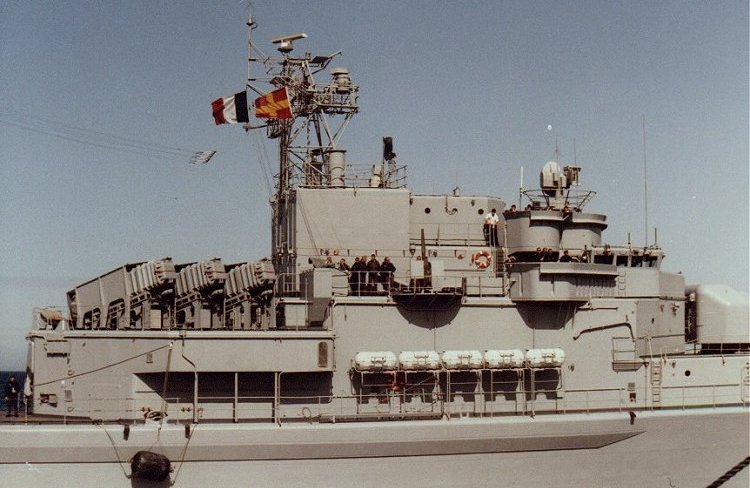
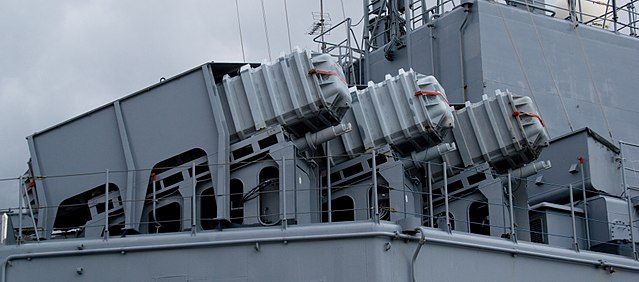
These MM38 (later MM40) Exocet SSM missiles were installed from the start, placed on two rows of three canisters angled, facing forward behind the bridge structure.
The was first deployed on warships from 1974. Range: 42 km.
⚙ specifications MM38 () |
|
| Weight | 780 kg (1,720 lb) |
| Dimensions | 6 m (19 ft 8 in) x 34.8 cm (1 ft 1.7 in) wp 1.35 m (4 ft 5 in) |
| Propulsion | Solid propellant engine |
| Speed | Mach 0.93 or 1,148 km/h (713 mph; 620 kn) |
| Range | 40 km (25 mi; 22 nmi) |
| Guidance | Inertial, active radar homing, and GPS |
| Ceiling | |
| Accuracy | |
| Payload | 165 kg (364 lb) |
Sea Crotale CIWS
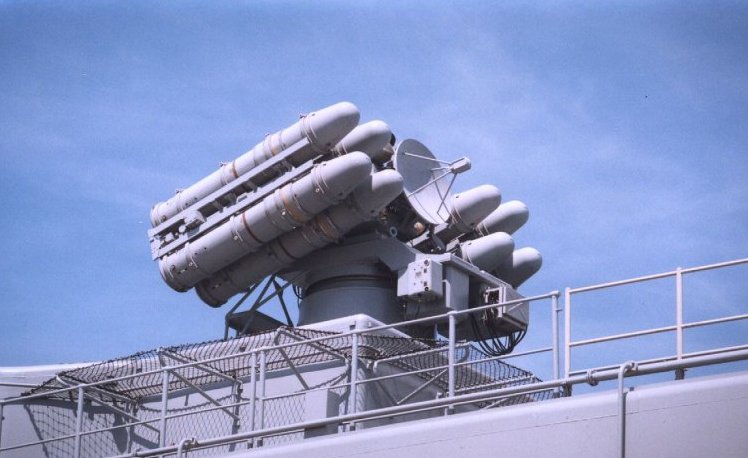
The Crotale EDIR SAM system (8-cells) was a small laucher short range AA and antimissile SAM installed aft, atop the hangar roof. Each launcher had eight canisters. This system, copied by many, incuding China started as a joint developement of Rockwell International and Thomson-Houston, plus Mistral in France for South Africa, under the Cactus project. It was later adopted by all branches of the French Armed Forces, including the navy. These were possibly replaced by the Crotale NG in the 1990s.
⚙ specifications R440 |
|
| Weight | VT-1: 76kg |
| Dimensions | 2.89 m x 15 cm x wp 54 cm |
| Propulsion | Lens 3 solid-fuel boost-glide |
| Speed | 800 m/s (Mach 2.3) |
| Range | 11 km |
| Guidance | Automatic command to line of sight, Canard and tail axis control |
| Ceiling | max 6,000 m |
| Payload | 15kg Forward-directed blast warhead or blast-fragmentation warhead (VT-1), infrared fuse |
Malafon ASWM (removed 1988)
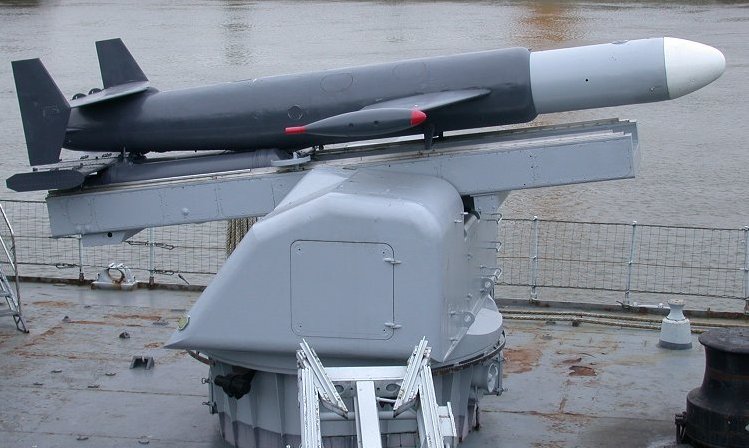
The frigates mounted from the start a Malafon anti-submarine missile system. Each ship carried 13 missiles and the magazine was situated in the aft deckhouse.
In short: Single launcher arm , hold with 13 spare missiles, radar-guided during initial flight. Payload 450mm (18 in) L4 torpedo, later L5. The missile accelerated to 830 km/h (520 mph), flew at 100 metres (330 ft) altitude and corrected trajectory via radio control up to 13 km (8.1 mi). The dropped homing torpedo swam at 30 knots (56 km/h; 35 mph) over 5 km (3.1 mi) to the target.
See the Malafon section on the La Galissonière destroyer for more info.
ASW: L5 Torpedoes
Like the Suffren instead of torpedo tube banks, these ships had two, not four catapult launchers for the L5 torpedo on either side of the ship in the main deckhouse, between mast and bridge. Ten torpedoes were carried inside.
The L5 Torpedo mode.4 took advantage of 4x better sonar ranges and three models were developed, the Mod 4. was the upgraded last variant of the mode. They could operate at depths of 1,800 feet (550 m) if needed, and were powered by a Silver-zinc Battery to 10,000 yards for Mod.4 and carried a 440 lbs. (200 kg) HBX-3 or TNT warhead. It was also capable of engaging a surface target as well, but were primarily ASW weapons.
Artillery: 2x 100mm
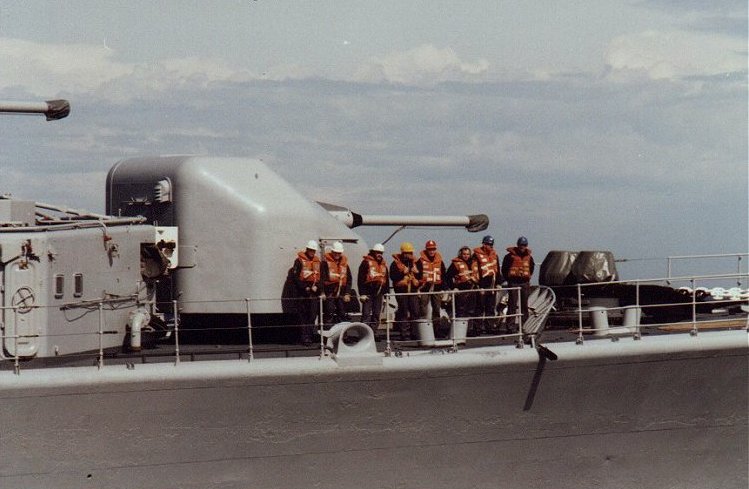
The frigates had two DCN/GIAT 100mm/55-caliber Mod.68 Compact DP Gun naval guns in superfiring position on the centreline. These dual-purpose guns were capable of lobbying an anti-surface shell at 9 nmi (17 km; 10 mi), each coming with a 13.5 kg (30 lb) warhead. In AA fire, thye fired an anti-air fuse shell at 4.4 nmi (8.1 km; 5.1 mi) but fire at 80 rounds per minute.
There was a CTMS (multisensor fire control) coupled with DRBC-33A radar and a Piranha II IR deviation meter plus TV camera to guide the 100mm guns as well as two DMA-a Panda optical stations.
At some point were added four single 20mm/70 Mk 4 Oerlikon for close defense in 1990 (see later).
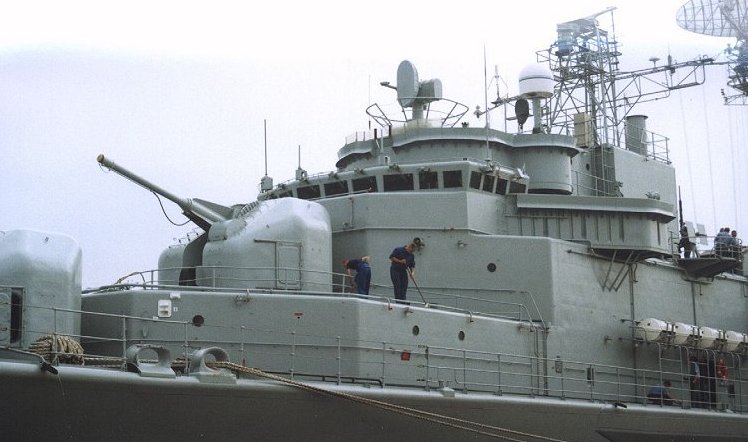
Artillery: 2x 20mm
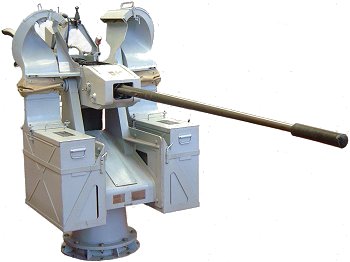 Later were added two GIAT 20F2 20mm machine guns in the superstructure amidship to defend against incoming close-in asymetric threats, and later completed by two 12.7 mm or cal.0.5 Browning HMGs for the same reason.
Later were added two GIAT 20F2 20mm machine guns in the superstructure amidship to defend against incoming close-in asymetric threats, and later completed by two 12.7 mm or cal.0.5 Browning HMGs for the same reason.
GIAT 20F2 20mm machine gun:
French weapon system long derived from the Swiss Oerlikon, this Gas unlocked, delayed blowback cannon was developed from the GIAT M693 in the 1980s, used by a large variety of French ships (nearly all) to this day.
Specs:
332 kg (732 lb), 2,600 mm (100 in) barrel 1,970 mm (78 in) elevation −15° to + 65°
Shell 20×139mm, 900 round/min, mv 1,050 m/s (3,400 ft/s) RA 1,500 m (4,900 ft) against aerial targets.
Sensors
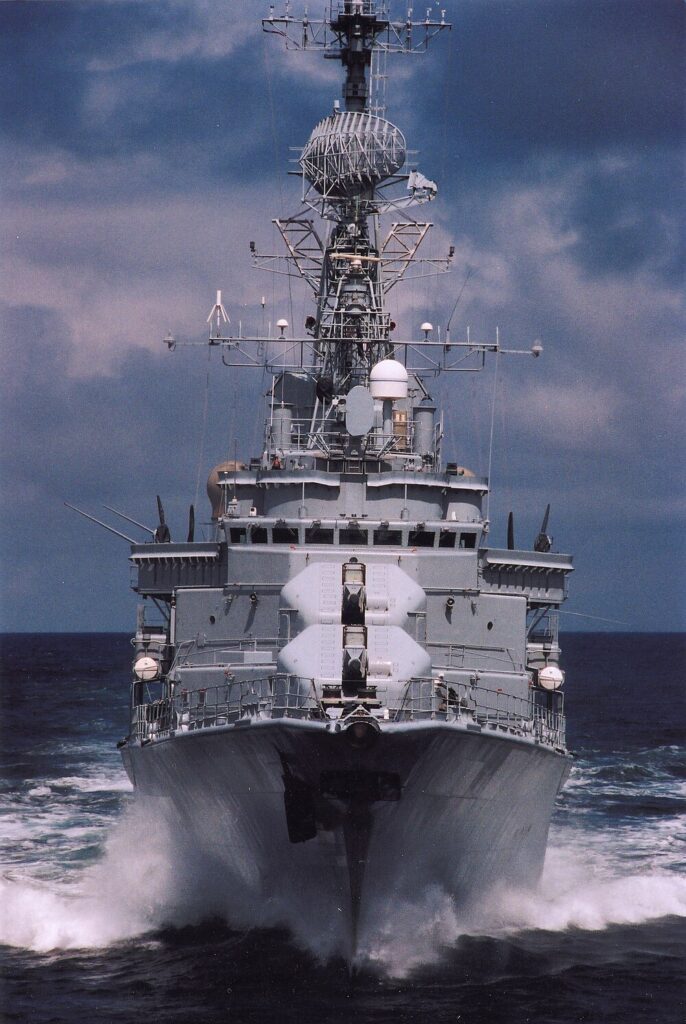
Radars
Note: Data to come in a future upgrade.
-DRBV 51B surface sentry radar
-DRBV 26A air sentry radar
-DRBC 32D targeting radar
-2 × DRBN 34 navigation radars
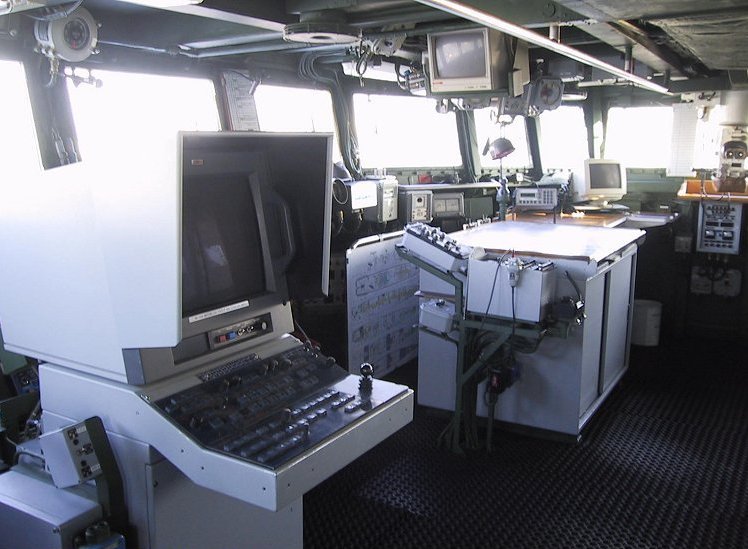
Sonars
-DUBV 23 hull sonar
-ETBF DSBV 62C sonar
-DSBX 1 towed sonar
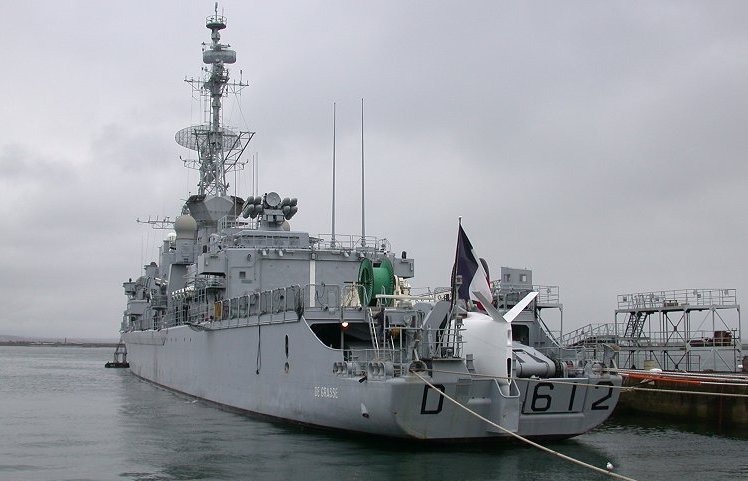
SLASM
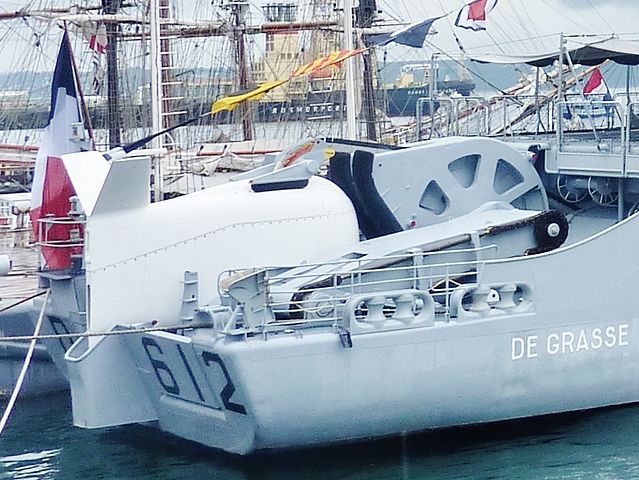
SLASM (Anti-Submarine Warfare System) is a French multistatic detection system. This consists for an ASW vessel transmitting with sonar, of “sharing” the echo return with another sensor (ship, buoy, submarine), which makes it possible to better locate the opposing submarine. This detection mode requires the use of very low frequency sonars. These sonars, the first of their kind, had heavy dedicated computers and suffered from low computing power. Thus, it took twelve hours of work for a supercomputer to analyze ten minutes of low-frequency emissions.
NavCoM
-Syva torpedo alert system
-SENIT 3 tactical data processing
-SEAO/OPSMER combat decision-making system
-HF, UHF, VHF and SHF liaison systems
-Syracuse 2
-Inmarsat
-Link 11
Electronic Warfare
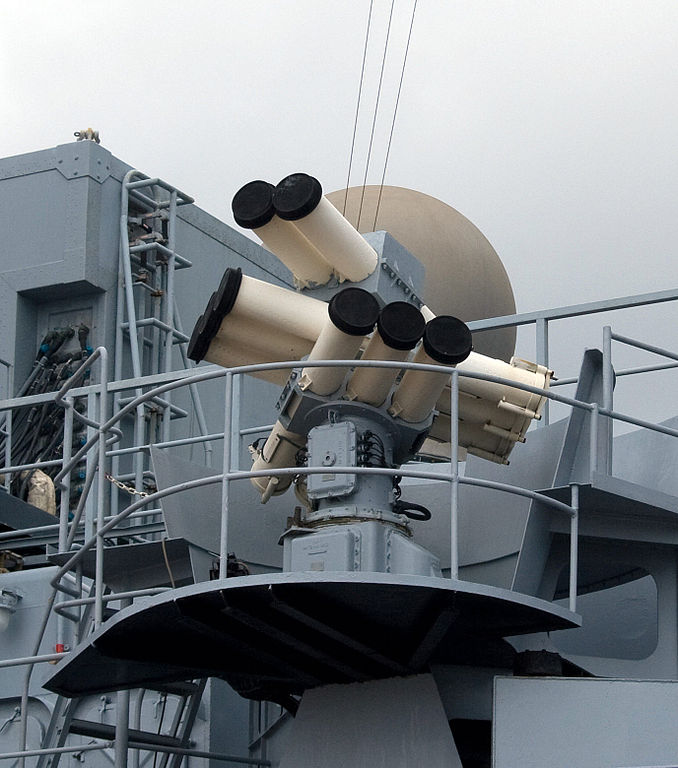
Syllex system
-ARBB 32 jammer
-ARBR 16 radar interceptor
-2 × Syllex decoy launchers
-Bubble belt
Air Group: Two Lynx WG13
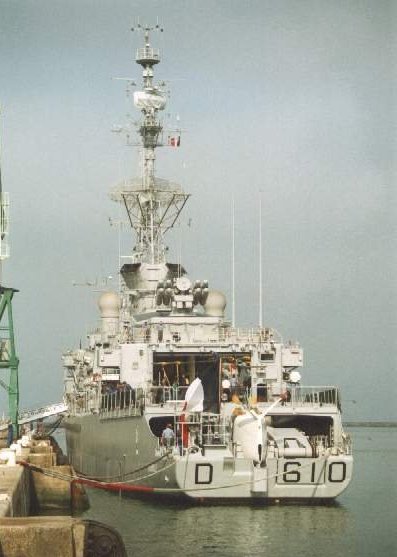 Left: View of the hangar and helipad. The first frigates to carry two capable Lynx helicopters were probably the biggest asset of these frigates, demultiplying their search and destroy capability in Anti-Submarine warfare by quite a margin. France took part in the development of this helicopter in the 1960s, Aerospatiale teaming with Westland based on common needs of both the Royal Navy and Marine Nationale, leading to an agreement in 1967. 450 were built and widely exported, with the British, French and German navies as former operators, 15 former and actual operators.
Left: View of the hangar and helipad. The first frigates to carry two capable Lynx helicopters were probably the biggest asset of these frigates, demultiplying their search and destroy capability in Anti-Submarine warfare by quite a margin. France took part in the development of this helicopter in the 1960s, Aerospatiale teaming with Westland based on common needs of both the Royal Navy and Marine Nationale, leading to an agreement in 1967. 450 were built and widely exported, with the British, French and German navies as former operators, 15 former and actual operators.
The Lynx W13 is basically the evolved version also called ‘Super Lynx’, first flying in 1971 and entering service in 1978. It was retired in 2020.
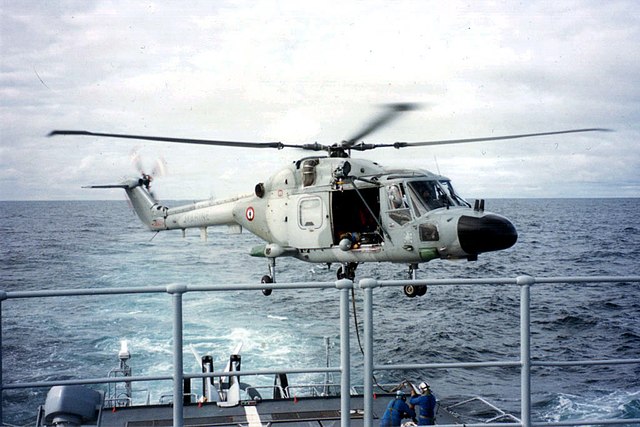
In its ASW variant, the WG.13 weights 10,181 lb (4,618 kg) carrying 2x homing torpedo or depth charges and detection buoys. It is powered by two LHTEC CTS800-4N turboshaft engines, 1,362 shpat 175 kn (201 mph, 324 km/h) over max 285 nmi (328 mi, 528 km) range, 540 nmi (620 mi, 1,000 km) with auxiliary fuel.

Conway’s Profile
⚙ specifications as completed 1975 |
|
| Displacement | 4,580 tonnes standard, 6,100 tonnes fully loaded |
| Dimensions | 152.75 x 15.80 x 6.60m (501 ft 2 in x 51 ft 10 in x 21 ft 8 in) |
| Propulsion | 2× shafts Rateau steam turbines, 4× multi-tubular boilers 58,000 shp (43,251 kW) |
| Speed | 32 knots (59 km/h; 37 mph) |
| Range | 1,900 nmi at 30 kn, 4,500 nmi at 18 kn |
| Armament | 2× 100 mm m1968, Masurca ASWM, 6x Exocet SSM, Crotale CIWS, 2× L5 torp.(10), see notes |
| Air group | 2× Lynx WG13 anti-ship helicopters |
| Sensors | DRBV 51B, DRBV 26A, DRBC 32D, 2 × DRBN 34, DUBV 23, ETBF DSBV 62C, DSBX 1, see notes |
| Crew | 24 officers, 160 NCO, 115 men |
Modernization
In 1979-81, all ships were modezrnized, gaining a NAVAL CROTALE anti-air missile system aft as well as a new fire control radar, an assoviated TV camera and Infrared systems to determine displacement angle. The Tourville and the De Grasse underwent significant modernizations between 1994 and 1996 as well, with the removal of the Malafon system and installation of the “SLASM” (Anti-Submarine Fighting System) multistatic detection system.
After only 24 years of service, in 1999, Duguay-Trouin was prematurely decommissioned. It was the only one not to have the SLASM including a low frequency towed sonar and 10 t fish and torpedo warning device. A serious fire in the engine spreading through the electrical cables in 1983 almost caused an even more premature end. It was narrowly brought under control. The policy of reducing the number of ships pos cold-war also prevailed. These vessels were essentially replaced by the new large 6,000 tonnes FREMM program frigates.
 FS Tourville (1972)
FS Tourville (1972)
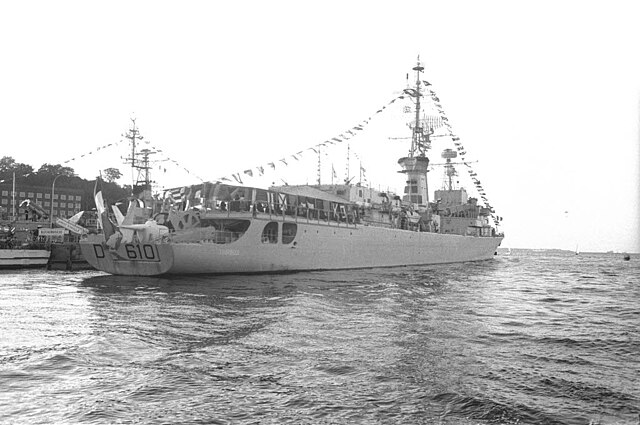
Tourville at Kiel week, West Germany, shortly after her service entry.
The Tourville was launched in 1972 and admitted to active service on June 14, 1975. It was withdrawn on June 16, 20111 then definitively decommissioned on November 10, 2011, it was moored on a safe at the Landévennec Ship Cemetery, near Brest in December 2012. It has served as a breakwater for Lanvéoc-Poulmic since October 2014 while awaiting her scrapping.
The frigate Tourville is sponsored by the Sovereign Order of Malta.
 FS Duguay Trouin (1974)
FS Duguay Trouin (1974)
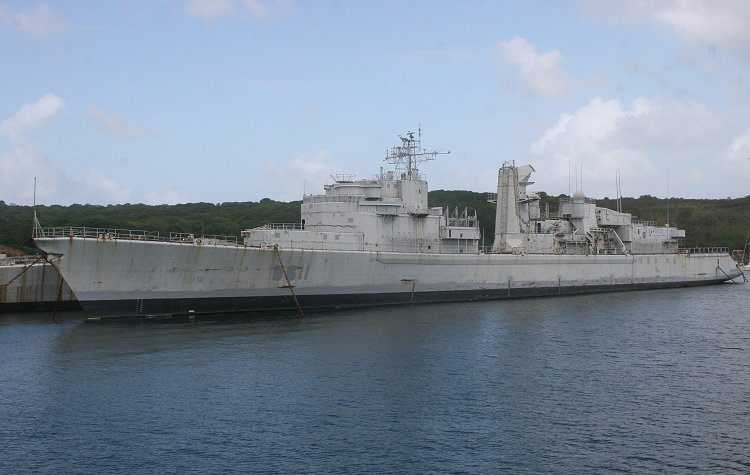
Based in Brest, the Duguay-Trouin was initially assigned to the Atlantic Wing, then to the Submarine Action Group, and was deployed mainly in the Atlantic.
On April 9, 1999 she returned from GEAOM to Brest with the helicopter carrier Jeanne d’Arc at groyne facility, Brest arsenal, completing a five-month world tour, including 168 days at sea. She took part in humanitarian operation after the Cyclone Mitch in Central America and made a historic stopover in Havana. She was scheduled to be retired and replaced by the frigate Georges Leygues.
By February 1999 she stopped in Tokyo, assisted the frigate Prairial to Honolulu, Hawaii before it, and stayed in Japan by February 1-6, in Wakasu, ten kilometers southeast of Tokyo.
It was a dispolmatic and economic mission. By March Euromarfor met GEAOM in Piraeus, Greece, and relieving the frigate Montcalm in Catania, La Motte Picquet became the French lead vessels of the Euromarfor squadron, joining the NRP Alvares Cabral, PITS Libeccio and the SPS Extremadura. They joined the helicopter carrier Jeanne d’Arc, Duguay-Trouin and Tourville, for a large scale training across the Mediterranean. Also in March 1999 she squadron stopped in Istanbul after a twelve-day transit in the Red Sea, Suez Canal to the Aegean Sea, Dardanelles Strait and Marmara sea, accompanied by the tanker Loire and minehunters Persée and Aquarius. They anchiored near the Dolinabahce Palace, confirming France’s interest in Turkey. Numerous meetings took place.
The last 2 years of her operational activity she was to be preserved for the retired helicopter carrier Jeanne d’Arc, as training ship for naval cadet officers. During her career, Duguay Trouin suffered two fires. The first in 1983 and the second in 1999. The latter was fatal due to the cost of repairs, but also the policy of reducing the number of vessels in the French Navy. She was decommissioned after 24 years of service, after travelling 650,000 nautical miles under the orders of 18 commanders.
Withdrawal from active service:
Decommissioned on July 13, 1999, its hull served as a breakwater near the Naval School in Lanvéoc-Poulmic until 2014. In August 2014, the Duguay-Trouin left the site for the port of Brest in order to be prepared for dismantling, it moved to the nearby Landévennec cemetery in November 2014, awaiting its destruction.
The boat served as a filming location for the TV film Fear on the Base (2017) by France Télévision in which he plays the role of the fictional ship La Constantine.
It was replaced by the Tourville and the De Grasse in Lanvéoc-Poulmic, which belong to the same class. In June 2018, the Galloo shipyard in Ghent, Belgium won the contract for the deconstruction of six ships including the Duguay-Trouin. She was towed to Belgium by the Dutch tug Multratug 3-30 June 2020 before dismantling in July.
 FS De Grasse (1976)
FS De Grasse (1976)
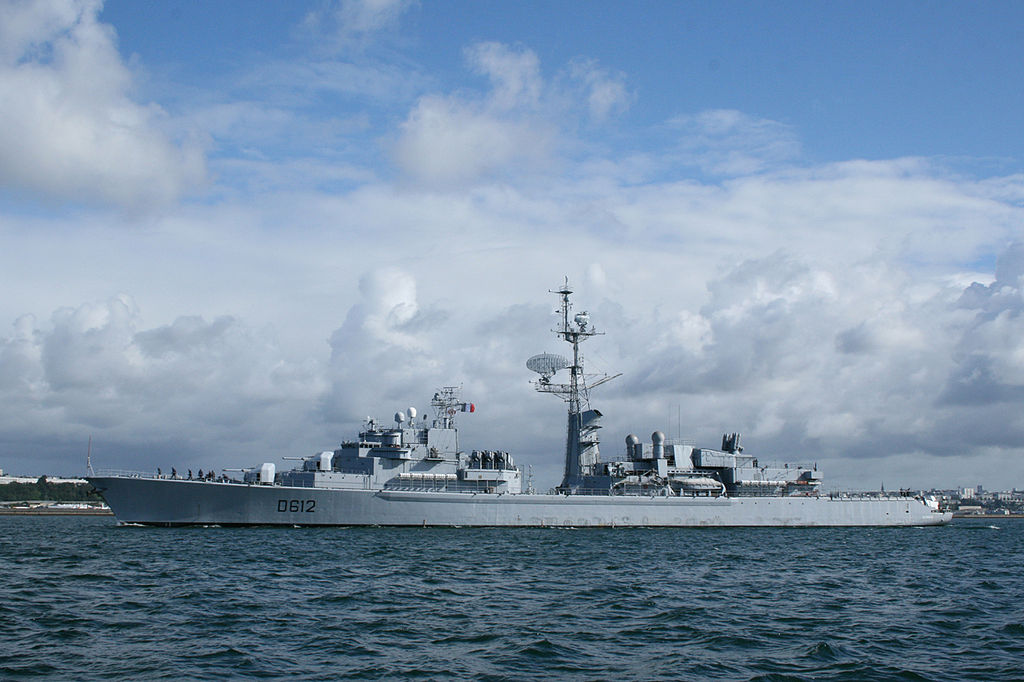
The De Grasse participated, first of all, in the protection of Brest Based french SSBN of FOST (Strategic Ocean Force) but also, and more broadly, surveillance and defense of French maritime approaches extended to French EEZ and interests in the world.
Based in Brest and assigned to the Naval Action Force, she was mostly deployed in the Atlantic. In 2002, De Grasse was deployed in the Indian Ocean for five months with De Gaulle’s carrier group as part of the allied response in Afghanistan following the attacks of September 11, 2001 called Operation Héraclès.
Her 2008 mission to Lebanon was another landmark:
After leaving her base on November 24, De Grasse returned to Brittany. The ship reached Brest the morning, Wednesday March 18, 2009, after having been integrated, for three months, into the naval component of the United Nations Interim Force in Lebanon (UNIFIL maritime ).
She was the Flagship of Task Force 448, coordinating action of around ten vessels from the French, Spanish, Greek, Turkish, German and Italian navies.
She was responsible for monitoring the Lebanese maritime approaches, in particular to avoid the illegal entry of weapons by sea, TF 448 acts in cooperation with the Lebanese army. Numerous training actions have thus been carried out with the Lebanese military, in order to enable them to ultimately ensure the sovereignty of territorial waters themselves.
For Europeans, this mission was also an opportunity to ensure cohesion between the nations of EUROMARFOR, a European air-maritime force created in 1995 by France, Italy, Spain and Portugal. From March 1, 2008 to March 1, 2009, EUROMARFOR assumed command of TF 448, first under the authority of Italian admirals, then French from September 1, 2008. On March 1, 2009, Rear Admiral Kérignard handed over command of the maritime component of UNIFIL to Admiral Pynoo of the Belgian Navy.
Acting off the coast of Lebanon, in accordance with UN Security Council Resolutions 1701 and 1832, TF 448 was deployed after the war of 33 days, in the summer of 2006, between Hezbollah and the Israeli army. From then on, France, which initially ensured the evacuation of nationals during the fighting, maintained a permanent naval presence. Many National Navy vessels took turns off the coast of Beirut. The ships based in Toulon were largely involved, but the participation of Brest units was also significant. Thus, before the De Grasse, the frigate Latouche-Tréville had already carried out a three-month mission in Lebanon, in the company of the command and supply ship Somme (based in Toulon). At the end of 2008, Mer et Marine embarked on the two ships, where we discovered the heart of a mission as complex as it was fascinating.
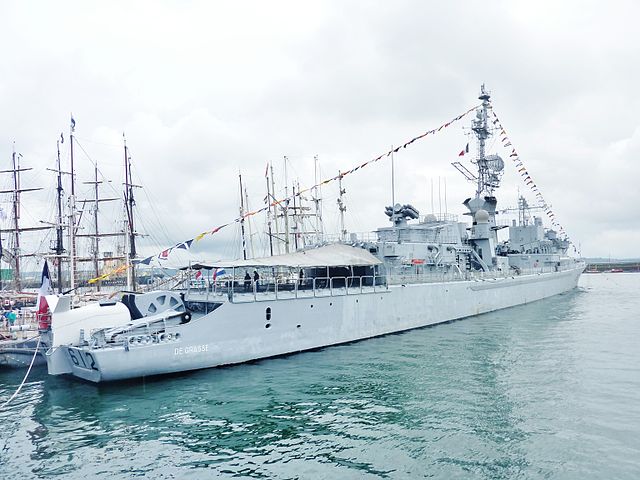
Read More/Src
Books
Michel Vergé-Franceschi (dir.), Dictionnaire d’Histoire maritime, Paris, éditions Robert Laffont, coll. « Bouquins », 2002
Jean Meyer et Martine Acerra, Histoire de la marine française : des origines à nos jours, Rennes, Ouest-France, 1994
Rémi Monaque, Une histoire de la marine de guerre française, Paris, éditions Perrin, 2016, 526 p.
Alain Boulaire, La Marine française : De la Royale de Richelieu aux missions d’aujourd’hui, Quimper, éditions Palantines, 2011
Gardiner, Robert; Chumbley (1995) Conway’s All the World’s Fighting Ships 1947-1995. Naval Institute Press.
Links
Full records netmarine.net, Tourville (FR)
on seaforces.org/
globalsecurity.org
https://preview.redd.it/french-tourville-class-frigate-de-grasse-d-612-showing-off-v0-r7lvkcwtcjn81.jpg?width=1080&crop=smart&auto=webp&s=47892dfdb220667933f1e206b2f24dcfc0324561
meretmarine.com/ fregate-de-grasse-retiree
fr.wikipedia.org/wiki/Classe_Tourville
netmarine.net/ degrasse
alabordache.fr /degrasse/
alabordache.fr/ /tourville/
alabordache.fr/ /duguaytrouin/
netmarine.net/ duguay/
corlobe.tk/ tourville_D_610.pdf
late logs De grasse netmarine.net/

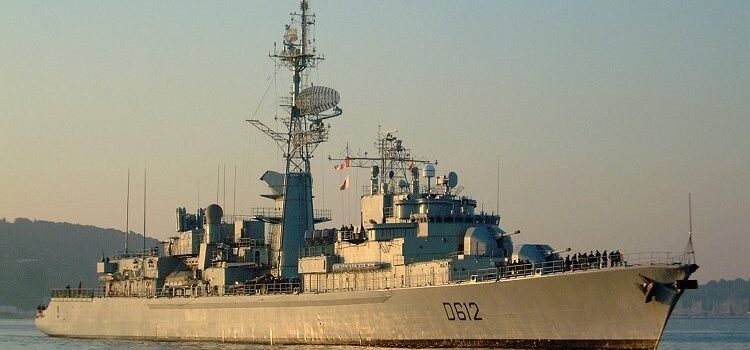
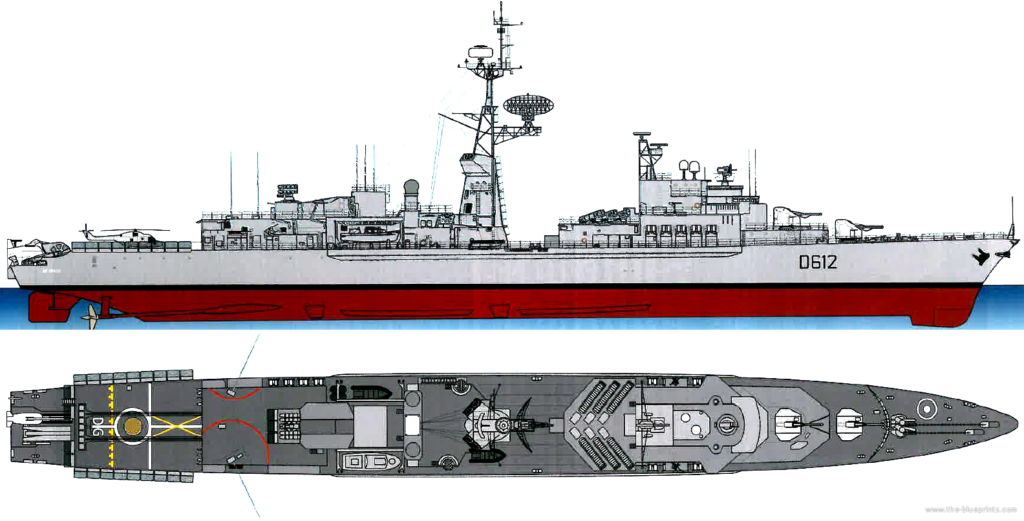
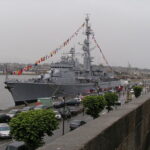
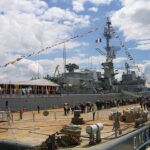
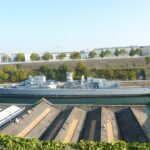
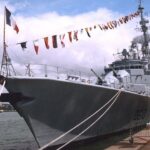
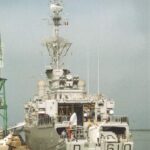
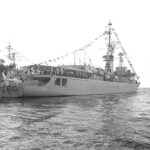
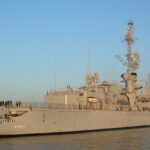
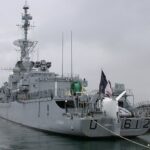
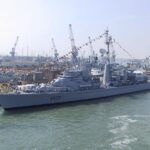
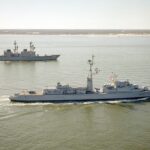
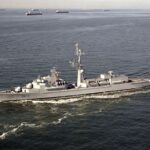
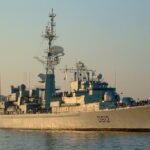
 Latest Facebook Entry -
Latest Facebook Entry -  X(Tweeter) Naval Encyclopedia's deck archive
X(Tweeter) Naval Encyclopedia's deck archive Instagram (@navalencyc)
Instagram (@navalencyc)





 French Navy
French Navy Royal Navy
Royal Navy Russian Navy
Russian Navy Armada Espanola
Armada Espanola Austrian Navy
Austrian Navy K.u.K. Kriegsmarine
K.u.K. Kriegsmarine Dansk Marine
Dansk Marine Nautiko Hellenon
Nautiko Hellenon Koninklije Marine 1870
Koninklije Marine 1870 Marinha do Brasil
Marinha do Brasil Osmanlı Donanması
Osmanlı Donanması Marina Do Peru
Marina Do Peru Marinha do Portugal
Marinha do Portugal Regia Marina 1870
Regia Marina 1870 Nihhon Kaigun 1870
Nihhon Kaigun 1870 Preußische Marine 1870
Preußische Marine 1870 Russkiy Flot 1870
Russkiy Flot 1870 Svenska marinen
Svenska marinen Søværnet
Søværnet Union Navy
Union Navy Confederate Navy
Confederate Navy Armada de Argentina
Armada de Argentina Imperial Chinese Navy
Imperial Chinese Navy Marinha do Portugal
Marinha do Portugal Mexico
Mexico Kaiserliche Marine
Kaiserliche Marine 1898 US Navy
1898 US Navy Sovietskiy Flot
Sovietskiy Flot Royal Canadian Navy
Royal Canadian Navy Royal Australian Navy
Royal Australian Navy RNZN Fleet
RNZN Fleet Chinese Navy 1937
Chinese Navy 1937 Kriegsmarine
Kriegsmarine Chilean Navy
Chilean Navy Danish Navy
Danish Navy Finnish Navy
Finnish Navy Hellenic Navy
Hellenic Navy Polish Navy
Polish Navy Romanian Navy
Romanian Navy Turkish Navy
Turkish Navy Royal Yugoslav Navy
Royal Yugoslav Navy Royal Thai Navy
Royal Thai Navy Minor Navies
Minor Navies Albania
Albania Austria
Austria Belgium
Belgium Columbia
Columbia Costa Rica
Costa Rica Cuba
Cuba Czechoslovakia
Czechoslovakia Dominican Republic
Dominican Republic Haiti
Haiti Hungary
Hungary Honduras
Honduras Estonia
Estonia Iceland
Iceland Eire
Eire Equador
Equador Iran
Iran Iraq
Iraq Latvia
Latvia Liberia
Liberia Lithuania
Lithuania Mandchukuo
Mandchukuo Morocco
Morocco Nicaragua
Nicaragua Persia
Persia San Salvador
San Salvador Sarawak
Sarawak Uruguay
Uruguay Venezuela
Venezuela Zanzibar
Zanzibar Warsaw Pact Navies
Warsaw Pact Navies Bulgaria
Bulgaria Hungary
Hungary

 Bundesmarine
Bundesmarine Dutch Navy
Dutch Navy Hellenic Navy
Hellenic Navy Marina Militare
Marina Militare Yugoslav Navy
Yugoslav Navy Chinese Navy
Chinese Navy Indian Navy
Indian Navy Indonesian Navy
Indonesian Navy JMSDF
JMSDF North Korean Navy
North Korean Navy Pakistani Navy
Pakistani Navy Philippines Navy
Philippines Navy ROKN
ROKN Rep. of Singapore Navy
Rep. of Singapore Navy Taiwanese Navy
Taiwanese Navy IDF Navy
IDF Navy Saudi Navy
Saudi Navy Royal New Zealand Navy
Royal New Zealand Navy Egyptian Navy
Egyptian Navy South African Navy
South African Navy






























 Ukrainian Navy
Ukrainian Navy dbodesign
dbodesign